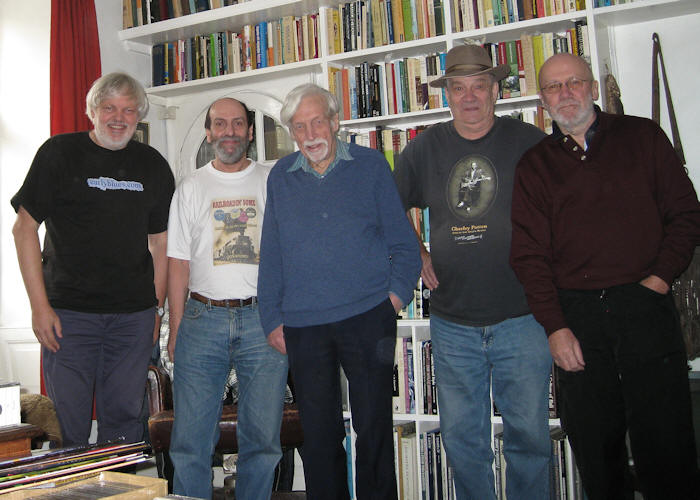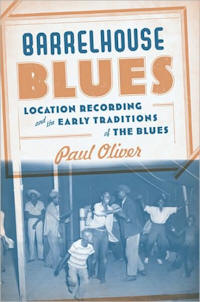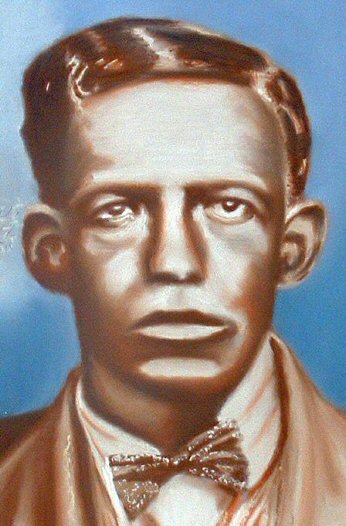
Painting © 2004 Loz
Arkle
Website
© Copyright 2000-2011 Alan White - All
Rights Reserved
Site optimised for Microsoft Internet Explorer
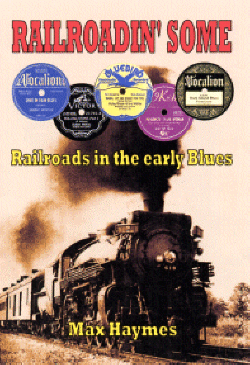
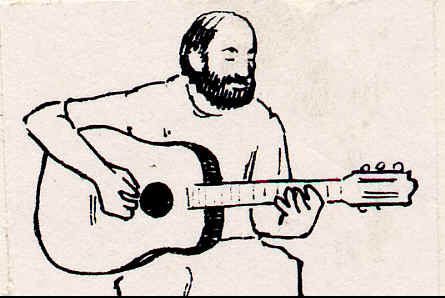

Early Blues Interview
|
|
Paul Oliver is one of the world's leading authorities and writer on the history of the blues. From an early age he collected blues records and books on the blues, publishing his first article in 1951. Since that time he has published thirteen books on the history of the blues and blues music including The Story of the Blues, Blues Fell This Morning, Conversation with the Blues, and Blues Off The Record. His work also includes interviews, field work and research in recording and printed sources tracing the origin and development of African American music and culture from the time of slavery through to the Twentieth Century. This work, known as "The Paul Oliver Collection of African American Music and Related Traditions" is held on a custodial basis at The University of Gloucestershire, England, by agreement with the European Blues Association and Paul Oliver. It represents an enormously valuable resource in teaching and research and is of international significance.
The 'blues musketeers', Max
and Rex Haymes, Dai Thomas, Robin
Andrews and myself, Alan White, are working on a long term project entitled 'Slave To The Blues' - tracing
secular roots of the blues back to slavery days; from 17th century
onwards. In planning our research we contacted Paul Oliver, who invited
us to his home for a weekend to discuss our work. During the discussions
I also had the honour of interviewing Paul about his work and his
thoughts on the blues. Alan: What are your first musical memories? Paul: Itís very difficult to identify your first musical memories because they are a little bit cloudy but I think the first time that music really played a part, and I played a part in it, was at Scout Camps, particularly the camp fires when I led the singing. My earliest clear recollections of particular song types really dates from then. But thatís a long while ago, back in the 1940s. Alan: What first attracted you to the Blues? Paul: It was particularly a friend of mine, who was actually killed in the war so I only knew him briefly, but we were at a Harvest Camp. These were camps that used to be put on for harvesting so the Scouts and young people could be employed because others were away in the services. I used to organise those camps, particularly logging camps as I was quite a good forester for some reason. On this particular occasion we were at a Harvest Camp, which I wasnít particularly interested in but at least one got to know interesting people, and then this chap, Stan Higham, came up to me and said, ďThereís something I want you to hearĒ. He took me down to a kind of hedge between the two farms and there was this extraordinary crying and yelling, I couldnít call it singing but it was quite spine-chilling. He said, ďDo you know what this is?Ē. I said, ďNo, Iíve no ideaĒ and he said ďYouíre listening to bluesĒ. He wasnít quite right really because we were actually listening to field hollers but nevertheless I thought it quite extraordinary. It was in Stoke- by-Clare in Suffolk and a lot of the American army sites were in Suffolk. He took me to a pub the following day, and there was a boogie pianist there, which was equally extraordinary. I went back to Stoke-by-Clare a few years ago to see how much it had changed and it still has a great kind of crescent around the green and the pub is still there (but no blues!). Alan: Could you tell me a little about your first article and how it came about. Paul: The first one wasnít really blues, it was for Jazz Journal and what I wrote about was gospel songs. I got interested in gospel quite early on, particularly because one or two blues singers had introduced me to it, because they were singing their religious songs as well and Iíd not really heard of it. I got interested in it, got interested with one or two preachers, did some research and wrote the article. But one of the key points I was making was that while focusing on writing about jazz and so forth to ensure itís permanence, we may be ignoring another folk music altogether. Alan: How did you become involved in producing graphics and writing notes for record sleeves? Paul: It wasnít difficult because I trained as an art student originally, first as a painter and then I took up sculpture. The problem with sculpture was that I was very asthmatic and very allergic to just about everything I used, including stone dust, some paint and turpentine. I therefore moved from painting and sculpture to graphic design. I was irritated by the designs of the sleeves on some of the first LPs I had so I just got in touch with Decca and, rather surprisingly, I managed to get through to Peter Gammond who wrote on popular music, jazz and so forth. He was in charge of the commissioning of the sleeve designs and was glad to have somebody who was interested in the music. An American artist had designed the cover for the first LP of Robert Johnson, a very fine drawing but to me it didn't seem focused on an LP, it was like a little art work in itself. Decca wanted me to attract people to buy by using different techniques, sometimes more figurative and sometimes more abstract, so they werenít just seeing the same image. That suited me fine and I greatly enjoyed doing that, even though not everybody liked it. The first one was the album Backwoods Blues, featuring Bobby Grant, Buddy Boy Hawkins, King Solomon Hill, Buddy Boy Hawkins, and Big Bill "Johnson" on the London Label (AL 3535 -Pub. 1954). One of the snags was the designer was not credited, and it was important to me to be credited so I smuggled in my initials. So you see youíve got the initials PHO in the design on the 1957 First National Skiffle Contest album. I had another one of New Orleans music and Iíd chosen the Wharf instead of obvious New Orleans sites so I had sacks on the wharf and one of them had PHO on it. When they asked me about it, I said ďItís phosphate.Ē Rex: Why wouldnít they credit you? Paul: Iíve no idea. Peter Gammond's boss was a difficult man and I suppose he just wanted the title on the sleeve with no interest in anything else. Alan: Your first book was in 1959 on Bessie Smith I believe. What inspired you to start with Bessie? Paul: I wasnít! What happened was that Desmond Flower was the Director of Cassell and Company, based in London and he was starting a series called "Kings of Jazz" and he asked me to do a book on Bessie Smith. Somebody had recommended me to him but I was in the process of working on Blues Fell This Morning and it was good that he was very pleased with the Bessie book. So when I told him about Blues Fell This Morning he asked to see it and then published it. Alan: Of all the blues publications, which has given you the most pleasure? Paul: Thatís a very difficult question because I get some pleasure out of all. Perhaps Blues Fell This Morning, in the sense of having it published, but it was over a long period of time so in one sense it was just relief. Perhaps Conversation with the Blues but mainly that's because of the echoes of the field workers. Alan: The wonderful Studio Vista series on Blues Paperbacks was published in 1970, which are very scarce now. Of course Yonder Come The Blues has republished three of them but are there any plans to republish the others? Paul: I had hoped that Yonder Come The Blues would sell well enough to use as a lever to do that but, well, sales are never high on this kind of thing. Iíd forgotten about it actually, I should try again. Alan: Difficult question, but who are your favourite blues artists? Paul: Well, I donít know any blues singers who are "artists". Itís often just whoever happens to be playing or singing at the time, although certain people who are particularly gifted at improvising lyrics and Iíve heard them do so. So possibly, Sleepy John Estes and Lightning Hopkins, I think, are the best improvisers. The singer whose quality of voice and guitar I particularly enjoy is Bo Carter, although his sexy lyrics get a bit boring after a while. And I like the Mississippi Sheiks, but I donít find it easy to answer. Alan: It is difficult and, perhaps equally difficult, do you have any favourite blues albums that stand out? Paul: I suppose it depends what an album is. Backwoods Blues is a favourite in the sense that it was a big starting off for me because I had the opportunity of designing for it so its my favourite in terms of personal association with it, rather than those I put together. But itís difficult to answer with 3000 12" LPs and 100 10Ē. Alan: Are there any particular songs that have special meaning to you? Paul: When you say ďsongĒ do you mean ďsongĒ as distinct to ďbluesĒ? Alan: Well, any blues. Paul: Oh, blues. I tend to think of ďsongĒ more in the ballad form in 16 bar against the 12 bar. Certain of them have a heroic figure like John Henry which also has an underlying moral position. I find most of the songs interesting but I donít think Iíd pick out any one of them. Alan: You have a collection related to African-American music and related traditions now held at the University of Gloucestershire in conjunction with the European Blues Association. Could you tell me a little about the collection? Paul: Itís not held by them, most of the material is still here. Originally I was appointing some trustees for my collection, for my will. Michael Roach is one of them and we began talking about it and he set up the Association which seemed like a good idea. But then we considered that the Trustees should make the decision on where certain things go, so some things don't go automatically to the University of Gloucestershire. The reason for Gloucestershire was that it has American Studies and Neil Wynn is quite interested in blues and he is the Head of the History Department. Curiously, heís particularly interested in the area that Max Haymes is interested in, slavery and post-slavery and the antecedents of blues so Iíll put you in touch with each other. The question arose as to how I would balance the collection [between the University and the EBA] by dividing mine so that each has early material and late material. I decided that it would be better if the Association had more things that could be a starting off point for people if they call in and see the pictorial history, that sort of thing, and the more academic studies should go to Gloucester. But obviously youíve got to get enough intelligent material available for the visitor and some visuals for Gloucester. Itís turning out to be a much slower process and itís surprisingly hard to part with anything! Alan: Youíre also an eminent Professor of Architecture and a distinguished author in that field. How on earth did you find time to do the incredible pioneering field research into the African-American music related traditions as well? It seems like two lifetimes to me. Paul: What I've tried to do is combine the two where possible. So Iíve done rather more field work in Africa, for example, than in India. I've done work in every continent, just more in some continents than others. Iím in Chicago next week and Iíll see Paul Garon while Iím there and weíll go to a few clubs to see whatís happening these days. Iím mainly on my way to New Zealand but thereís not so much happening there. Although there is a Blues Society in New Zealand, which has been going for many years. Alan: I get emails from New Zealand about the earlyblues.com website, and from Australia too. Paul: Bob Dixon [Professor of Linguistics and co-author with John Godrich of the definitive discography of Blues and Gospel Records: 1890-1943] lives in Australia and his wife, Shelley, is Russian and she has the most extraordinary linguistic skills. She must be one of the leading people in the world. There is barely a European language she canít speak or respond to but her main work has been with the Berber and Bob Dixonís main work has been with the Australian Aboriginals. He did work with the Dyirbal tribe on their language called Dyirbal and one of the interesting things was whilst he was talking with them certain words and structures were quite unfamiliar to him, even though heíd been learning to speak Dyirbal. He couldnít understand this and thought they were talking two languages but it turned out that Dyirbal has a "mother-in-law language" which is apparently a language that you used to speak to your mother-in-law. Of course, everybody has to learn it but there is only one person they can use it with; most extraordinary. Alan: In all your field work, how did you get sponsorship? Paul: I didnít get very much but I got it initially for my first field trip. Iíd been working with the American Embassy for a long time; they had a very good library and I was often the only person in it, sometimes the only person theyíd see in a week. American Embassy was so open and such a nice place in those days but what came later were threats of bombing and they had to change their policy. But at that time the US Information Service were very helpful and supportive of me so they eventually said, ďWell, you still havenít been to the US, why donít you go? There is a grant for leaders and specialists and if you care to make an application for the grant, weíll be ready to support itĒ. So I did, and Richard Wright and a friend of his who was known as the Black Ambassador from the United States supported me and I got the grant. It wasnít huge but I think it was the travel and $1,000 which was a lot in those days. I didnít get any future grants of a similar kind but I got grants periodically from the university for field work. Sometimes my architectural work took me to places which allowed me to spend time in the field too. Alan: Are there any memories of your field work which youíd like to share with us? Paul: I have written in my books about the things that make a story but what is not so easy to convey is how you respond in situations. What stays in the mind over a long period can really be quite trivial; things that certain people wear, or when it hasnít worked out as well as Iíd have liked. I went to Baton Rouge on my way to New Orleans, for example, but I found it was very self-conscious and it felt like everybody was sitting there just waiting for somebody to come and ask them questions. Baton Rouge, by the way, was of course named for the 'red post' where Indians used to mark out their territory. Alan: Looking back over many years of achievements, is there anything you wish youíd done that you hadnít. Paul: One thing Iíd like to do is finish this autobiography which a lot of people have been pressing me a long time to do. Iíd also like to make sense of a few things which are quite difficult to do Ė even the kind of question you are asking me in a way. I started a book several years ago and itís still nowhere near completion. Itís what I called The Blues the World Forgot which is on aspects which had either been under-examined or had been at one time but ignored since. Itís been snoozing for too long, really. Alan: We always refer to the "Bible of the Blues" being the Blues and Gospel Records: 1890-1943 by Robert Dixon, John Godrich and Howard Rye which I understand was dedicated to you and is now in its 4th edition published in 1997. Do you know if thereís going to be another edition coming out? Paul: No, I donít know at all but I would have thought there might have been. Howard Rye is probably the person to ask. He joined it rather late and of course John Godrich died and I havenít heard from Bob Dixon since he retired and moved to Cairns, Northern Australia. Alan: Blues is the background to so much modern music. Why do you think that is? Paul: I donít know if there is an answer to that. It depends what you mean by ďbackgroundĒ or whether it is really placed against that background or whether itís part of the elements that cause it's development. Rock 'n Roll or Rhythm and Blues and so forth were indications of certain kinds of emphases with probably rather less of the content and more of the patterns which people can drum to, or whatever. Alan: How do you see the future of blues music? Paul: I have been surprised that there is as much; for example, I get one or two of the magazines from Europe, ASB is a very good French journal and Block is Belgian, and I have been surprised that there are so many old blues singers who are still working. They are far more responsible in the way in which they are approaching the research they are doing. They are very lively and optimistic magazines and show how much is happening elsewhere. Alan: Final question Paul, whatís next in the pipeline? Paul: As you know Iíve only just published Barrelhouse Blues and Iím looking forward to seeing the reviews because sometimes that can get your mind working. Iíd also like to finish Blues the World Forgot. More imminently, we can have a cup of tea, if you like? Alan: Thank you Paul for your time,
_________________________________________________________________________
_________________________________________________________
Note: If you wish to reproduce this interview in whole or
part, _________________________________________________________ Return to Blues Interviews List
Website, Photos © Copyright 2000-2009 Alan
White. All Rights Reserved. |





